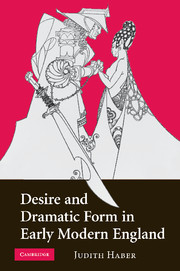Book contents
- Frontmatter
- Contents
- Acknowledgments
- Textual note
- Introduction: consummate play
- Part I “COME … AND PLAY”: CHRISTOPHER MARLOWE, BESIDE THE POINT
- Part II DESIRING WOMEN IN THE SEVENTEENTH CENTURY
- 5 “How strangely does himself work to undo him”: (male) sexuality in The Revenger's Tragedy
- 6 “My body bestow upon my women”: the space of the feminine in The Duchess of Malfi
- 7 “I(t) could not choose but follow”: erotic logic in The Changeling
- 8 “Old men's tales”: legacies of the father in ’Tis Pity She's a Whore
- 9 The passionate shepherdess: the case of Margaret Cavendish
- Afterword: for(e)play
- Notes
- List of Works cited
- Index
7 - “I(t) could not choose but follow”: erotic logic in The Changeling
Published online by Cambridge University Press: 02 July 2009
- Frontmatter
- Contents
- Acknowledgments
- Textual note
- Introduction: consummate play
- Part I “COME … AND PLAY”: CHRISTOPHER MARLOWE, BESIDE THE POINT
- Part II DESIRING WOMEN IN THE SEVENTEENTH CENTURY
- 5 “How strangely does himself work to undo him”: (male) sexuality in The Revenger's Tragedy
- 6 “My body bestow upon my women”: the space of the feminine in The Duchess of Malfi
- 7 “I(t) could not choose but follow”: erotic logic in The Changeling
- 8 “Old men's tales”: legacies of the father in ’Tis Pity She's a Whore
- 9 The passionate shepherdess: the case of Margaret Cavendish
- Afterword: for(e)play
- Notes
- List of Works cited
- Index
Summary
One of most disturbing allusions in all Renaissance drama occurs at the end of Act 3 of Thomas Middleton and William Rowley's The Changeling. In an earlier scene, the soon-to-be-married Beatrice Joanna had persuaded her hideously ugly servant and admirer, De Flores, to kill her betrothed so that she might wed Alsemero, her new beloved (2.2.57–155). Now, in an exchange that parallels this earlier “seduction” (inverting its power relations), De Flores makes evident his intention to claim his reward through rape. Beatrice kneels and sues for deliverance, but he refuses, raises her, and as she shivers in mute fear, declares:
’Las how the turtle pants! Thou'lt love anon
What thou so fear'st and faint'st to venture on.
(3.4.169–70)His words are clearly meant to recall the epithalamium from Ben Jonson's masque Hymenaei. In the first stanza of that poem, Jonson begins to focus on the wedding night, and asks that “no object stay … / The turtles from their blisses.” Three lines later he begins the second stanza by counseling the bride, “Shrink not, soft virgin, you will love / Anon what you so fear to prove” (403–5, 408–9).
The allusion is significant on a number of levels. Hymenaei was written, of course, to celebrate Frances Howard's 1606 marriage to the Earl of Essex – an occasion that proved to be extremely embarrassing for its author.
- Type
- Chapter
- Information
- Desire and Dramatic Form in Early Modern England , pp. 87 - 102Publisher: Cambridge University PressPrint publication year: 2009



